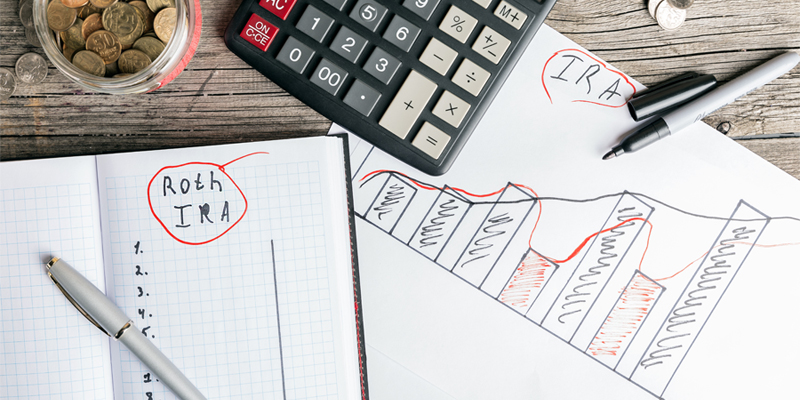Introduction
When approaching the age to begin required minimum distributions from retirement accounts, many investors may benefit from a Roth conversion. A Roth conversion is the process of taking funds from a Traditional/Rollover Individual Retirement Account (IRA) and “converting” such funds to a Roth IRA. Depending on an investor’s tax bracket, a Roth conversion may allow certain investors to recognize significant tax savings. Unlike other retirement accounts, Roth IRAs do not require the distribution of funds during the lifetime of the account owner—providing additional planning flexibility.
Early Roth conversions may be a particularly good idea this year because of reduced asset values due to the recent market downturn. In addition, the changes brought about by the SECURE Act of 2019 have shown Roth conversions to be an even more valuable tool now that next generation beneficiaries have a reduced time frame during which they are required to make withdrawals.[1] There is no longer an age cap on Traditional IRA contributions past the age of 70 ½ as a response to longer life expectancies and additional years spent being active in the workforce, allowing more time for potential growth. Distributions now have to be made in full over a 10-year period, so preexisting stretch provisions in Inherited IRAs have essentially been eliminated. Change brings opportunities and there’s an underlying benefit to start implementing goals ahead of the curve to pave the way to a more secure financial future.
West Capital Management believes that a Roth conversion can be a useful planning technique for certain investors and could be advantageous to overall investment success. Below we provide a general overview of the Roth conversion process and invite you to contact us for further details.
Retirement Plans Requiring Distributions
After decades of hard work, some investors find themselves retiring with a large sum held in a qualified account, such as an IRA, SIMPLE IRA, SEP IRA, 401(k), Profit-Sharing, and/or 403(b). These accounts are excellent savings tools because contributions are generally made pre-tax, with all taxes from growth and/or income within the account deferred until withdrawn. Because the contributions were not taxed when contributed, the investor will owe ordinary income tax upon withdrawal. Furthermore, the IRS requires that investors take distributions from these accounts each year after they reach age 72 (and are also retired with respect to the 401(k), profit sharing, and 403(b) plans). These distributions are called “Required Minimum Distributions” (RMD’s), and the RMD amounts are calculated pursuant to a specific equation set forth by the IRS.[2] As the investor ages, a greater percentage of the account value is required to be distributed. Depending on the size of the account, RMD’s, which are treated as ordinary income, can be large enough to significantly increase an investor’s tax rate.
Required Minimum Distributions (RMD’s)
The deadline for taking RMD’s as adjusted by the SECURE Act is April 1st of the year following the year you turn 72 and December 31 in each following year. If you were born on or before June 30, 1949, you must continue or begin taking RMDs under the old rule.[3] RMD’s are required to be taken from IRAs (including SEP and SIMPLE IRAs) and 401(k)’s, 403(b)’s, Profit Sharing Plans, and other defined contribution plans. When taking an RMD related to IRAs, an Investor may calculate the total RMD from all IRAs and distribute the RMD from a single account. When taking an RMD from a 401(k) or similar plan, each specific plan account must take a separate distribution. Please contact your WCM team to complete paperwork for such distributions, and to set up automatic distributions going forward in order to avoid missing future deadlines.
Roth IRA Plans
Similar to the pre-tax retirement accounts above, Roth IRA assets are not subject to taxes on growth and/or income while in the account. Unlike the accounts above, there are no required minimum distributions from the account during the owner’s lifetime. Further, the investor is not taxed on funds taken out of the plan.[4] Tax-deferred growth combined with tax-free distribution makes the Roth IRA an excellent retirement savings tool.
Investors, however, are limited as to how much they can contribute to a Roth IRA account. The maximum contribution to both traditional and Roth IRAs in 2020 is $6,000 ($7,000 for investors over 50).[5] However, for Roth IRAs, this contribution amount is reduced when the investor has reached certain adjusted gross income levels. For instance, a phase-out begins for an investor (filing as single) when his or her adjusted gross income reaches $124,000; eligibility is completely eliminated when the investor’s adjusted gross income is over $139,000. If taxpayers are filing Married/Jointly, the phase-out occurs at AGI between $196,000 and $206,000.[6] While this precludes direct contributions to Roth IRAs for those with income levels in excess of the thresholds, IRS accepts what is typically referred to as “back-door” Roth IRA contributions by making a non-deductible contribution to a Traditional IRA and then immediately converting it to a Roth IRA during the same tax year.[7] This strategy can allow investors across all income levels to utilize Roth IRAs. While this process is generally straightforward, we recommend you contact us to ensure the strategy is executed properly.
Roth Conversion
The IRS allows investors to add additional funds to a Roth IRA, unrelated to the annual contribution limits, through a unique strategy called a Roth conversion. With this strategy, investors can “convert” retirement funds from an IRA to a Roth account with no phase out related to the investor’s income level. The conversion is done by taking a distribution from the IRA account, paying the tax at the investor’s current ordinary income tax rate, and then placing the funds into a Roth account.
A conversion is generally beneficial when investors find themselves in a lower tax bracket in the short term with the expectation of a tax bracket increase in the long term due to factors such as social security, pension, RMDs, or investment income. The strategy creates a tax savings by utilizing the lower current tax rate as opposed to the potentially higher future tax rate—the larger the gap between current and future tax rates, and the longer the duration of the difference, the more beneficial the strategy. The conversion also lowers the amount of assets held in the IRA account, thereby lowering the future RMD amounts (and the corresponding potential tax rate increase).
Therefore, investors with an IRA who have a low current tax rate and expect a higher future tax could benefit from the Roth conversion strategy. Utilizing income smoothing to potentially increase earnings during low earning periods and market instability is possible with Roth conversions in the period between retiring and distributing income from those investments. However, if an investor currently has high income and does not expect a large increase in the future, or if an investor has smaller amounts in IRA accounts which would not create a significant income increase at age 72, this investor likely would not benefit from the strategy.
Conclusion
The Roth conversion strategy may offer a tax savings to certain investors. However, it is not recommended for all investors. If you have any questions about the strategy, please contact your West Capital Management Team who can provide guidance on your individual situation. When planning this strategy, please keep in mind the following timing considerations in 2020:
- Deadline for 2019 IRA contribution – July 15, 2020
- Deadline for 2020 Roth Conversion – December 31, 2020
Please note that because the Roth conversion depends critically upon your tax rates, you should confirm all figures with your tax advisor prior to undertaking a conversion.

Helping you boost your financial intelligence.
Read our financial resources from your friends at WSFS.




